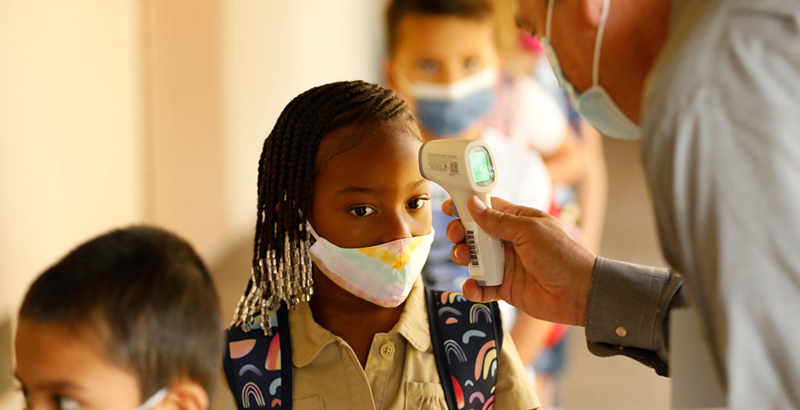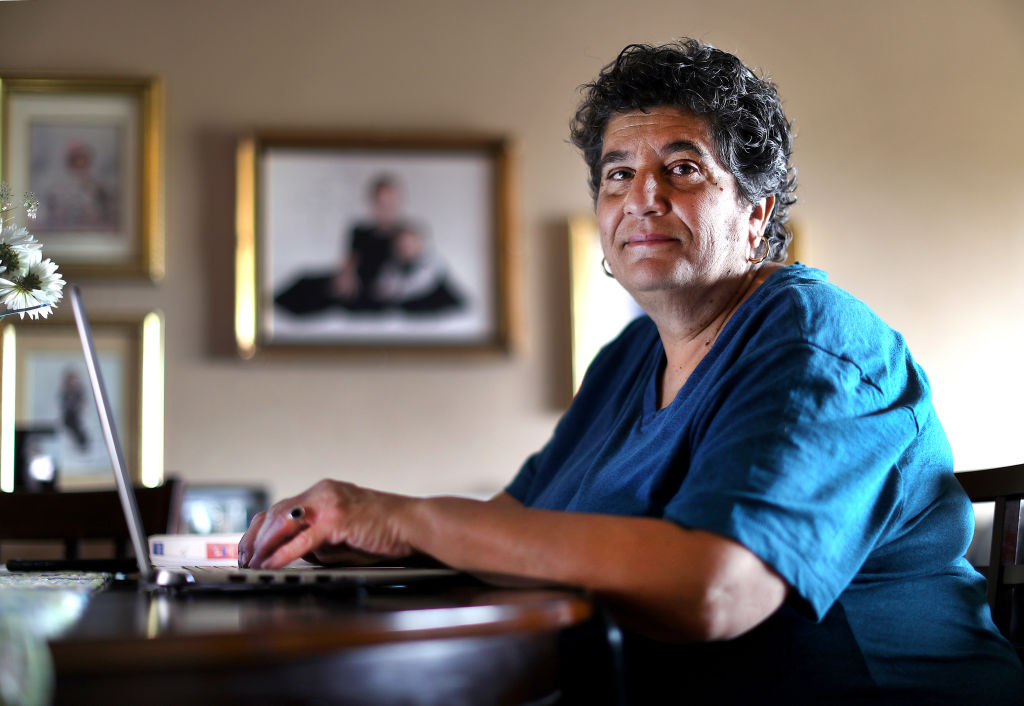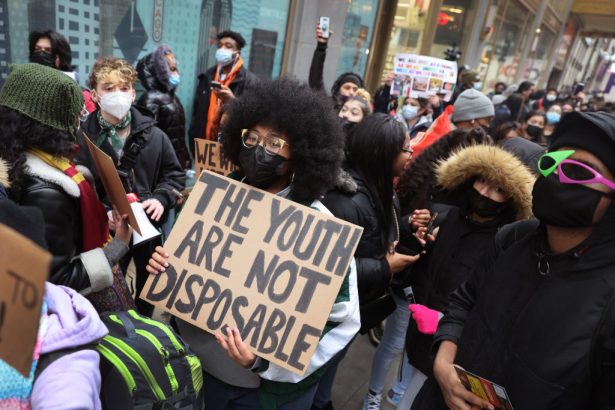The End of K-12 Contact Tracing? Some Schools Say Symptoms, Not Exposure, Should Spur Tests

Get stories like these delivered straight to your inbox. Sign up for The 74 Newsletter
Updated
It’s long been an underlying logic of pandemic safety for schools: In order to contain COVID transmission, identify which students and staff have been exposed to the virus and make sure they quarantine or test negative before coming back to class.
That wisdom appears to be changing, however, in the wake of the Omicron surge, which experts say may have now peaked in many U.S. communities, but continues to strain K-12 operations.
Three New England states — Massachusetts, Vermont and Connecticut — have recently announced new guidance recommending a pivot away from individualized contact tracing in schools and toward strategies like symptom monitoring and home test kits for those worried that they may be sick.
“We are recommending that school health personnel increase their focus on identifying symptomatic individuals, rather than monitoring in-school close contacts,” Massachusetts Education Commissioner Jeffrey Riley, Massachusetts wrote in a Jan. 18 memo.
“Individuals identified as close contacts in school are very unlikely to contract or spread COVID-19,” he continued. “Therefore, extensive contact tracing and associated Test and Stay procedures are not adding significant value as a mitigation strategy despite the demand they place on the time of school health staff and school staff at large.”
New York announced in mid-January that it was ending its statewide contact tracing program, which was for the general population rather than K-12 specific. And individual school systems including Bekeley, California; Brevard County, Florida; York, Maine and Delaware Valley, Pennsylvania have also opted to ease away from the practice, often ramping up other mitigation strategies instead.
Contact tracing puts a “now-impossible workload” on school districts, Berkeley Unified School District Superintendent Brent Stephens wrote in a Jan. 15 message to parents. The school system is now offering twice-weekly testing to every K-12 student, regardless of exposure, and is investing in highly protective KN95 masks for students and staff.
A pre-Omicron study of classroom transmission in California and Illinois published by the Centers for Disease Control and Prevention found that roughly just one individual out of every 100 school-based close contacts of positive cases, on average, ultimately got sick themselves — casting into doubt, for some experts, the added value of the labor intensive practice of cross-checking rosters to track in-school exposure.
Then came the Omicron variant, spurring record-breaking infection levels. In Yonkers, New York, a quarter of students tested positive. In Providence, Rhode Island, some classrooms had more students absent or quarantining than present in class. Last week, across the country, more than 1.1 million young people caught the virus, a pandemic record and over four times more than at any point during previous surges.
The ultra-rapid spread made it next to impossible for some districts to accurately track exposures, school leaders said.
“Omicron is spreading more quickly than contacts can be traced. Contact tracing for this variant is ineffective,” wrote Lou Goscinski, superintendent of Maine’s York School District, in a Jan. 13 message to the community explaining that the practice would be discontinued.
Indeed, the timeline from exposure to transmission is faster with Omicron than with Delta or other strains of the virus, scientists say. For districts that are practicing universal masking, that means “contact tracing doesn’t do much as a preventative measure,” said Danny Benjamin, co-chair of the ABC Science Collaborative at Duke University, which examines COVID-19 spread in schools.
“By the time you figure out who was in the room, were they really close, were they vaccinated, the list goes on and on, it’s now a couple of days after exposure and that child is now infectious,” Benjamin told The 74. “So [contact tracing] is not as helpful to contain the disease as we were seeing with the ancestral variant or the Delta variant.”

From a labor standpoint, too, Omicron made contact tracing less tenable, said Linda Mendonca, president of the National Association of School Nurses. Tracking exposure was already a heavy lift for school personnel, usually requiring nurses to scour seating charts from mealtimes, bus rides and classrooms every time a student would test positive. In many cases, that work continued into the weekends because schools needed to keep sick or potentially exposed students from showing up on Monday, she said. At some schools, nurses had to let the typical yearly screening of students’ eyesight and hearing go by the wayside because the contact tracing programs took up so much of their time.
Then after the winter holidays, skyrocketing caseloads pushed many schools’ case tracking programs past the breaking point.
“I heard many school nurses just saying, ‘This is not manageable. We can’t keep doing this at this … capacity,” Mendonca told The 74.

Regardless, the longtime school nurse chose not to comment on whether now is the right time to ditch contact tracing altogether.
“We’re waiting to see what the CDC comes out with,” she said, emphasizing the continued importance of mitigation strategies like masking, ventilation and vaccination.
The last update to CDC guidance on contact tracing in schools came in mid-October, according to the agency’s website, which says the practice remains an effective strategy for reducing COVID spread in schools when used alongside other layered mitigation strategies.

But Benjamin is willing to take a stronger stance. Even amid Omicron, COVID transmission in schools remains low when all students and staff are wearing masks, he said. His team has a forthcoming paper that answers a key question: How many close contacts in fully masked schools develop infections after being exposed to the highly infectious variant?
“If everyone’s wearing masks, it’s still under 5 percent, but it’s no longer in the 1 percent range,” he said, referring to the secondary transmission rate in school under the earlier strains.
Those numbers combined with Omicron’s speed of transmission and the logistical headaches of exposure tracking lead him to believe contact tracing may no longer be a necessary or useful measure for schools that are universally masking. But for schools that aren’t mandating face coverings, he takes a different tune.
“In the unmasked districts, you probably want to [continue contact tracing],” said the Duke University doctor, explaining that the practice can help determine whether specific individuals who were exposed should mask going forward so as not to infect others and test, tactics known as mask to stay and test to stay.
“It interrupts the chain between a bunch of us infecting each other,” said Benjamin.
As cases begin to subside in some, but not all, parts of the country, many schools are now scrapping mask rules. Virginia Gov. Glen Younkin’s executive order to let parents opt out of school face-covering requirements took effect on Monday (although it is now facing legal challenges). And two Long Island districts recently voted to end their requirement that students wear face coverings in school when the New York state masking mandate expires on Feb. 1.
A New York state judge, meanwhile, ruled on Monday night that the mandate was unconstitutional and can’t be enforced, but that decision was quickly stayed by an appellate court judge Tuesday afternoon. For now, New York’s mask mandate will remain in place until the appellate court decides whether to uphold or overturn the lower court’s ruling. The back-and-forth created at least temporary confusion for school leaders Tuesday and fueled school mask opponents, with the hashtag #UNMASKOURCHILDREN trending on Twitter.
Meanwhile, students themselves are spooked. In early January, young people in New York City staged a walkout to protest what participants said were unsafe conditions in schools. Thousands of students joined the demonstration, calling for more COVID safety mitigation measures and a temporary pivot to remote learning.
In the following days, students in Round Rock, Texas; Oakland, California; Montgomery County, Maryland and Chicago have also staged walkouts making similar demands.

Samantha Farrow, an organizer of the New York City walkout and a high school junior in the city, said that her school did not notify her when her desk-mate in French class left halfway through the school day after testing positive. The high schooler only found out about the exposure, she said, because that student texted her directly.
“No one tells students anything and it feels like we’re getting left out of the loop,” Farrow told The 74 in early January. “It’s not fair to us because we’re the ones being impacted by this.”
Get stories like these delivered straight to your inbox. Sign up for The 74 Newsletter

;)
